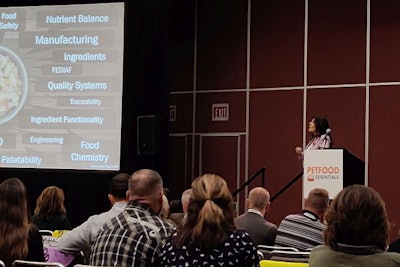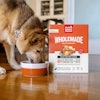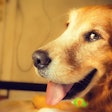
New pet food product developers aim to fill dog, cat and other pet food company’s innovation funnel with creative products and creative ideas that create new opportunities in the market, Leah Lambrakis, vice president, research, development and innovation, Simmons Pet Food, said during her presentation at Petfood Essentials on May 2 in Kansas City, Missouri, USA.
Ensuring sustainable growth for a pet food company depends on that business’ ability to stay in lockstep with what is new and innovative in the market, and staying relevant, she said.
“A successful brand requires two key and intentional strategies in order to do this: sound science and strong marketing.”
However, nutritional science and consumer demands are not always consistent. Pet owners may demand certain ingredients, formulations or formats regardless of what animal nutritionists advise. New pet foods, treats, supplements and other products must balance science and marketing.
“Without the strength behind the science, a product will not perform and uphold the quality and nutritional standards that we expect,” she said. “Without sound marketing, the product does not have the story to draw in the pet parent.”
To attract pet owner attention, labeling claims help a brand stand out. However, the pet food market now has a wide range of competing products all trying to be unique. This can make it hard to stand out.
“Pet parents are looking for pet foods with purpose not only nutritious, but functional in some ways somewhat personalized to their pets needs or to their own feeding philosophy or beliefs,” she said.
Lambrakis divided this wide range of pet food label claims into four categories: nourishment, health, quality and planet.
Nourishment
“Many claims suggest that a product is more premium when it has advanced, elevated terms and descriptions,” she said. “These are often called puffery claims in that they draw in the pet parent by the use of wording that speaks to them and that their product is better for your pet. This does not mean that necessarily a lot of research or scientific evidence or validation has come behind those claims. We do need to be careful when we want to have integrity behind our product.
“High in protein nutrient-rich would be examples of what are often called puffery claims,” she said. “Highly digestible is another one. Did you run digestibility trials? Or are you simply assuming that the design would be considered highly digestible, such as high meat or wet food or raw food by design?”
- Advanced and elevated
- Ingredient emphasis
- Personalized
Health
“You see a lot of associations happening [in the health trend] from us to our pets,” she said. “There certainly is more popularity by pet parents to care for the health of their pets and brands are elevating their product lines with these points of differentiation notably targeting immunity calming effects, digestive care, and the care of the microbiome and overall wellness.”
- Immunity
- Calming
- Digestive care
- Skin and coat
- Hairball, urinary, low Mg
Quality
“We often see claims that have implied manufacturing process practices,” she said. “These can also be considered puffery claims, because there’re really no standards behind claims such as handcrafted in our own kitchen, small-batch, slow cooked. Some of these can be very misleading. For example, for us at Simmons, we have batch sizes that are in our plants from 10,000 pounds down to 1,200 pounds. Does that mean that the products that we produce in a 1,200 pound batch is small for our plant? Yes, but that does not mean that we can say that it is small batch produced, nor would we feel comfortable saying so.”
- Free-from claim
- Natural, human-grade
- Hand-crafted, small batch
- Made in the USA
- Safety, traceability, transparency
Planet
“Pet owners increasingly demand sustainability and social responsibility,” she said. “More and more pet food brands and manufacturers are being asked, Where do the ingredients come from? Where are they sourced? What is the chain of custody, the country of origin? What are the animal welfare and handling practices? And can the package be recycled? The stakes are certainly higher that we need to be taking care of our people, our pets, our animals, our waters, the whole planet. I recently read this statement in an article by food industry executive that really sums up my messaging on this slide that claims on packaging must be specific, substantiated and verifiable.”
- Responsible sourcing
- Animal raising
- Marine safe
- Packaging
The new pet food product development teams tasked with staying on top of those trends need effective communication and structured processes, she said.
“Seeing our team's set loose on a project without clarity or deliverables, timelines and scope or alignment from top-down really is not realistic and likely a waste of crucial resources and time,” Lambrakis said.


















